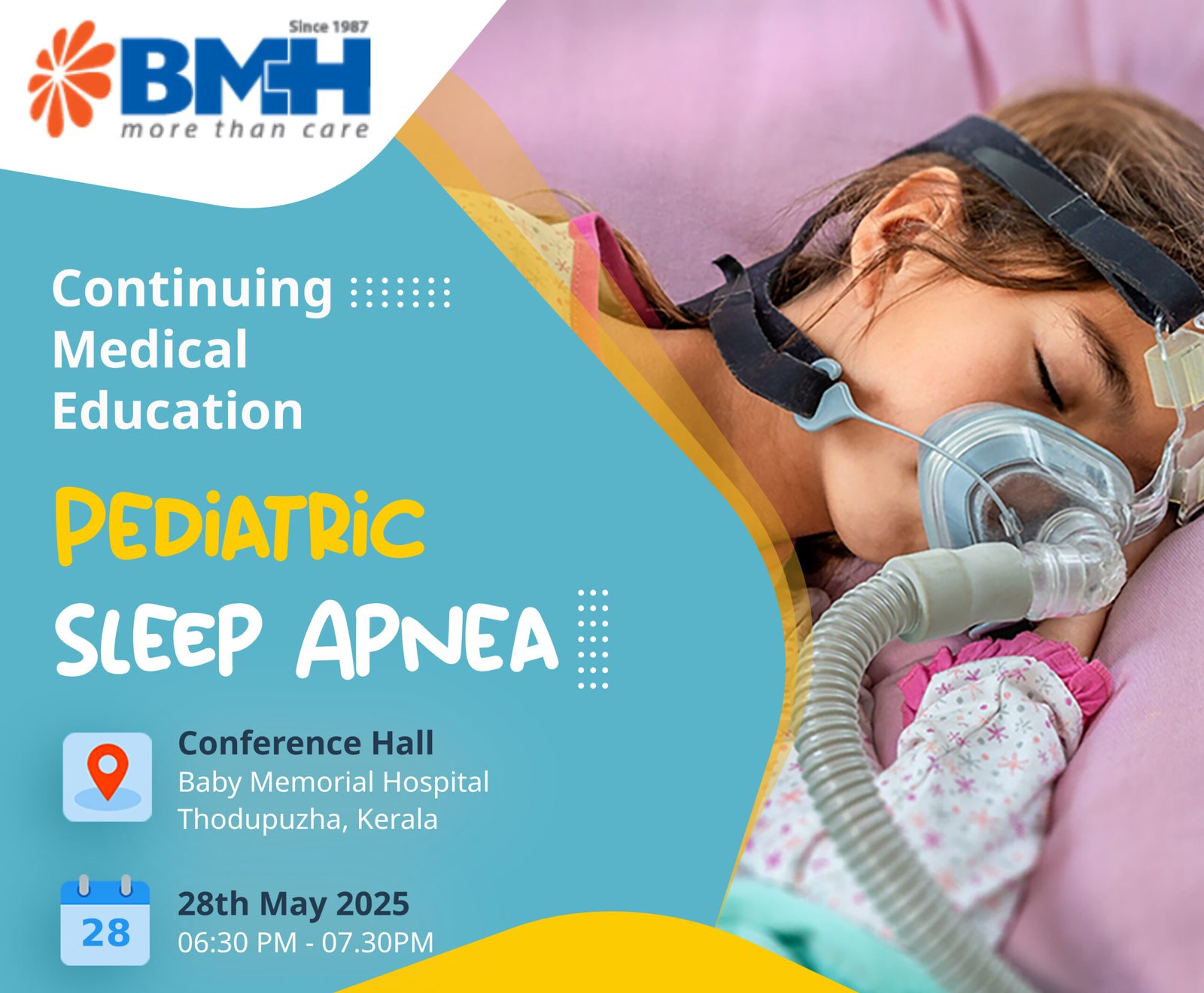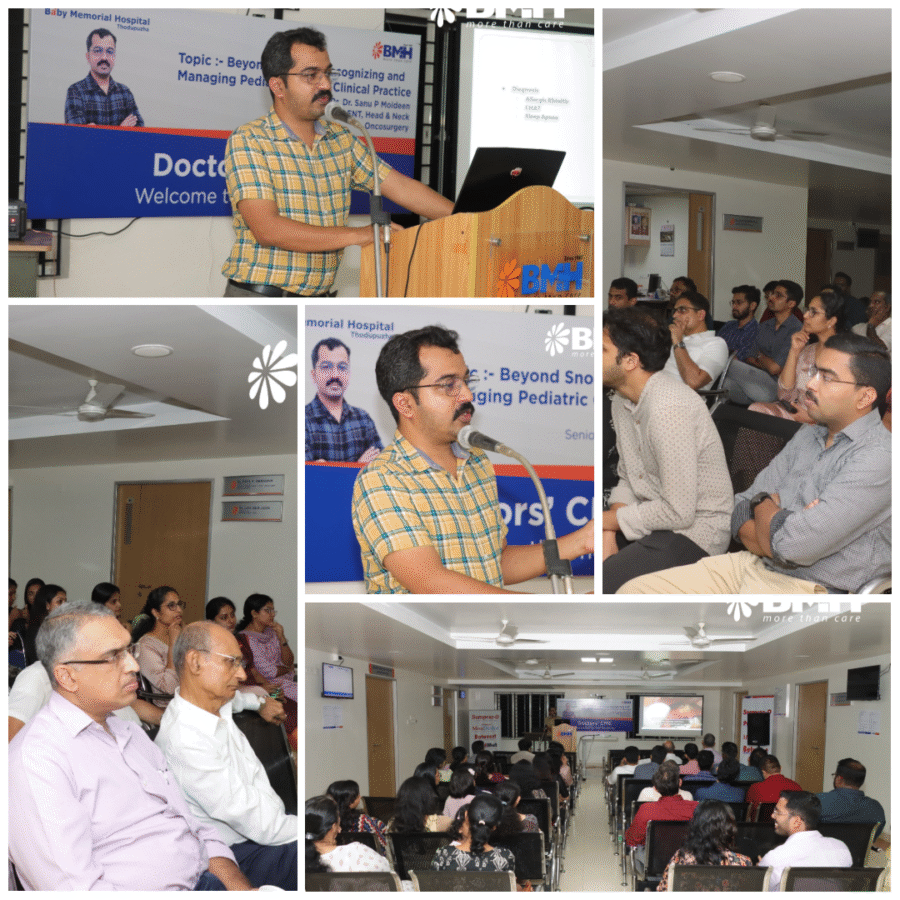
On May 28, 2025, I had the opportunity to lead a Continuing Medical Education (CME) session at Baby Memorial Hospital, Thodupuzha, centered on an often underappreciated but increasingly prevalent condition—Pediatric Obstructive Sleep Apnea (OSA).
The session was designed not just as a lecture but as a practical, case-based discussion, complete with surgical video demonstrations, evidence-based guidelines, and peer interaction. The aim was simple: to equip our fellow clinicians with a comprehensive, updated, and patient-friendly approach to pediatric OSA.
Understanding Pediatric OSA: More Than Just Snoring
Pediatric OSA differs in many ways from adult OSA. While loud snoring and restless sleep are classic red flags, children may also present with:
- Daytime behavioral problems (irritability, hyperactivity, poor school performance)
- Mouth breathing and nasal speech
- Nighttime symptoms like bedwetting, night terrors, and frequent awakenings
- Failure to thrive in severe cases
- Unfortunately, these symptoms are frequently attributed to unrelated pediatric or psychological issues, delaying proper diagnosis.
Clinical Evaluation: A Structured Approach
During the session, we discussed a step-by-step framework for evaluating suspected cases of pediatric OSA:
- Detailed Sleep History – Including snoring patterns, witnessed apneas, sleep quality, and nocturnal awakenings.
- Daytime Functioning Assessment – Attention issues, hyperactivity, mood changes, and fatigue.
- Physical Examination:
- Tonsillar grading
- Adenoid facies
- Nasal obstruction (allergic rhinitis, deviated septum)
- Craniofacial anomalies (micrognathia, midface hypoplasia)
- Nasal Endoscopy – Especially valuable in assessing adenoidal hypertrophy and nasal pathology.
- Sleep Study (Polysomnography) – When available, PSG remains the gold standard. However, in resource-limited settings, a combination of history, examination, and overnight oximetry may help triage cases.
- Treatment Protocols: Tailoring to the Child
We outlined a tiered treatment strategy based on severity and etiology:
- Mild OSA / Intermittent Symptoms:
- Trial of intranasal corticosteroids
- Leukotriene receptor antagonists (e.g., montelukast)
- Allergy management
- Weight optimization in obese children
- Moderate to Severe OSA or Failed Medical Therapy:
- Surgical intervention is the mainstay. Adenotonsillar hypertrophy remains the leading anatomical cause.

Surgical Excellence: Demonstration of Modern Techniques
To illustrate current best practices, I shared recorded surgical demonstrations of:
Intracapsular Tonsillectomy
A technique where only the obstructive portion of the tonsil is removed, preserving the capsule and minimizing nerve exposure. This approach offers:
- Less postoperative pain
- Lower bleeding risk
- Faster return to normal diet and activity
- Better patient and parent satisfaction
Endoscopic Coblation Adenoidectomy
With this technique, adenoid tissue is precisely removed under direct endoscopic vision using coblation. This allows:
- Complete and targeted clearance
- Avoidance of blind curettage
- Protection of the Eustachian tube orifices
- Documentation of surgical field for future follow-up
Multidisciplinary Collaboration
One of the key messages of the session was the need for a team-based approach to Pediatric OSA. Pediatricians, ENT specialists, sleep physicians, and even orthodontists have critical roles to play. Early diagnosis and treatment can prevent long-term complications such as poor growth, learning disabilities, and cardiopulmonary issues.
We also briefly touched on the role of orthodontic interventions, CPAP therapy in selected cases, and myofunctional therapy in children with persistent OSA post-surgery.
The session turned highly interactive as we engaged in Q&A, exchanged clinical scenarios, and discussed real-world challenges. Many of my colleagues found the video demonstrations particularly helpful in understanding the finer technical aspects of coblation surgery and intracapsular dissection. It was rewarding to see their interest in adopting these less invasive, evidence-based techniques in their practice.
Conclusion: Towards Better Sleep and Better Lives
Pediatric OSA is a growing health concern that affects not just the child’s sleep, but every aspect of their development and well-being. Through better awareness, structured clinical evaluation, and minimally invasive treatment options, we can ensure that children breathe, sleep, and live better.
I extend my heartfelt thanks to the administration and academic team of BMH Thodupuzha for facilitating this CME session and to all the participants who brought energy, curiosity, and commitment to advancing patient care.
Let’s continue to evolve—from cold steel to coblation, from assumptions to evidence, and from symptomatic relief to comprehensive care.